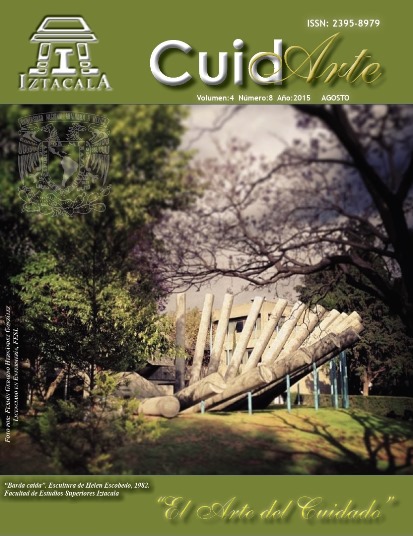Experiences of older adults in a physical activation group to improve their self-care
Main Article Content
Abstract
Aging involves a series of
morphological, psychological, functional and
biochemical changes in humans, characterized
by progressive loss of adaptability and reserve
capacity of the organism to changes. Why support
groups in the health institutions are called upon
to create a cozy atmosphere, it has been shown to
belong to them favor new ties and social relations
to their members. Physical activity and coexistence
are factors that benefit the health of people, it has
been shown that these practices in older adults, has
several positive effects. Objective: To interpret the
experiences of older adults in physical activation
program to enhance self-care. Methodology:
Qualitative research with phenomenological
method, in-depth interviews were conducted at 5
seniors. Findings: emerged two analytical categories,
the first category: Healthcare Improvement two
subcategories 1.1 ease of physical movement and
motivation for self-care 1.2. The second category:
2. Social recognition with two subcategories: 2.1
the importance of communication 2.2 sense of
belonging. Conclusions: Self-care is an excellent
strategy for the group of older adults because they
recognize their own physical and mental abilities,
self-assessed as useful and active, exercise and
coexistence provided them physical but also
created emotional bonds and a marked coexistence
strengthened social relationships, according to
informants also contributed to an emotional being.
Downloads
Article Details
References
(1) Gutiérrez LM. Transición epidemiológica como proceso de cambio en Geriatría. México: Manual Moderno. 2008. p.3-122.
(2) Rosalía Rodríguez García, Guillermo Antonio Lazcano Botello, Humberto Medina Chávez, Miguel Ángel Hernández Martínez., Práctica de la geriatría. Envejecimiento exitoso. México: Mc. Graw Hill.; 2011. p.18- 28.
(3) Sánchez C, Alonso TJ. Reflexión sobre la actividad física en la salud de adultos mayores. Cuidarte “El arte del cuidado”. [Revista on- line] 2014; 3 (5): 53-59. [acceso 15 de mayo de 2015]; Disponible en: http://journals.iztacala.unam.mx/index.php/cuidarte/issue/view/53/showToc
(4) Gutiérrez RLM, María del Carmen García PMC, Arango LVE, Pérez UM, Geriatría para el médico familiar. México: Manual Moderno; 2012.
(5) Maldonado G. G, Carbajal-M. FE, Rivera V.P, Castro G.RI. Beneficios que percibe el adulto mayor al integrarse a un grupo de ayuda dirigido por personal de enfermería Rev Enferm Inst Mex Seguro Soc. 2015; 23(1):31-6. [acceso 25 mayo de 2015.]; Disponible en: http://revistaenfermeria.imss.gob.mx/
(6) Arboleda N.LH. Beneficios del ejercicio. [Acceso el 10 de febrero del 2015]. Disponible en: http://promocionsalud.ucaldas.edu.co/downloads/Revista%208_8.pdf
(7) OMS. La actividad física en los adultos mayores. [Acceso el 07 de junio del 2015.], de:http://www.who.int/dietphysicalactivity/factsheet_olderadults/es
(8) Orem D. Modelo de Orem. Conceptos de enfermería en la práctica. España: MASSON-SALVAT; 1993. p 139.
(9) Dorothea E. Orem: Teoría del déficit de autocuidado. En Marriner, TA. y Raile, M.,Modelos y teorías en enfermería 6°ed. Barcelona: ELSEVIER; 2011.p 267-295.
(10) Díaz O. El hombre y sus vivencias. [Acceso el 25 mayo del 2015.]; de: https://diazolguin.wordpress.com/2008/07/17/el-hombre-y-sus-vivencias/
(11) Diccionario Definición ABC. [Acceso el 07 de junio del 2015.] Disponible en: http://www.definicionabc.com/social/vivencia.php
(12) Rodríguez, G. Gil F. García J. Metodología de la Investigación cualitativa. 3ª ed. Málaga España: ALJIBE; 1997. p. 168, 170, 204.
(13) Souza, M. La artesanía de la investigación cualitativa 7° ed. Buenos Aires: Lugar Editorial; 2009. p.114
(14) Reglamento de la Ley General de Salud en Materia de Investigación. Última reforma publicada DOF 02-04-2014. [acceso 25 de enero de 2015.]; Disponible en: http://www.diputados.gob.mx/LeyesBiblio/regley/Reg_LGS_MIS.pdf
(15) Sanhueza P.M, Castro S. M, Merino EJ. Optimizando la funcionalidad del adulto mayor a través de una estrategia de autocuidado. Avances en enfermería. vol. xxx n. ̊ 1 enero-abril 2012. [Acceso el 07 de marzo del 2015.]; Disponible en: http://www.enfermeria.unal.edu.co/revista/index4.htm
(16) Jiménez OY, Núñez M, Coto VE. La actividad física para el adulto mayor en el medio natural. Inter Sedes: Revista de las Sedes Regionales 2013XIV168-181. [acceso 13 de abril de 2015.]; Disponible en: http://www.redalyc.org/articulo.oa?id=66627452

